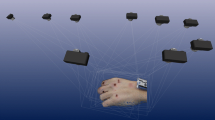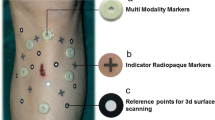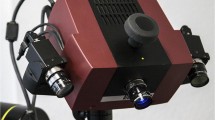Abstract
Three-dimensional (3D) measurement techniques are gaining importance in many areas. The latest developments brought more cost-effective, user-friendly, and faster technologies onto the market. Which 3D techniques are suitable in the field of forensic medicine and what are their advantages and disadvantages? This wide-ranging study evaluated and validated various 3D measurement techniques for the forensic requirements. High-tech methods as well as low-budget systems have been tested and compared in terms of accuracy, ease of use, expenditure of time, mobility, cost, necessary knowhow, and their limitations. Within this study, various commercial measuring systems of the different techniques were tested. Based on the first results, one measuring system was selected for each technique, which appeared to be the most suitable for the forensic application or is already established in forensic medicine. A body of a deceased, a face and an injury of a living person, and a shoe sole were recorded by 11 people with different professions and previous knowledge using the selected systems. The results were assessed and the personal experiences were evaluated using a questionnaire. In addition, precision investigations were carried out using test objects. The study shows that the hand-held scanner and photogrammetry are very suitable for the 3D documentation of forensic medical findings. Their moderate acquisition costs and easy operation could lead to more frequent application in forensic medicine in the future. For special applications, the stripe-light scanner still has its justification due to its high precision, the flexible application area, and the high reliability. The results show that, thanks to the technological advances, the 3D measurement technology will have more and more impact on the routine of the forensic medical examination.











Similar content being viewed by others
References
Brueschweiler W, Braun M, Fuchser H, Dirnhofer R (1997) Photograrnmetrische Auswertung von Haut- und Weichteilwunden sowie Knochenverletzungen zur Bestimmung des Tatwerkzeuges -grundlegende Aspekte. Rechtsmedizin 7(3):76–83. https://doi.org/10.1007/BF03042360
Thali MJ, Braun M, Kneubuehl BP, Brueschweiler W, Vock P, Dirnhofer R (2000) Improved vision in forensic documentation: forensic, 3-D/CAD-supported photogrammetry of bodily injury external surfaces, combined with volumetric radiologic scanning of bodily injury internal structures, provides more investigative leads and stronger forensic evidence. P Soc Photo-Opt Ins 3905: 213–21. https://doi.org/10.1117/12.384876
Thali MJ, Braun M, Markwalder TH, Brueschweiler W, Zollinger U, Malik NJ, Yen K, Dirnhofer R (2003) Bite mark documentation and analysis: the forensic 3D/CAD supported photogrammetry approach. Forensic Sci Int 135(2):115–121. https://doi.org/10.1016/s0379-0738(03)00205-6
Thali MJ, Braun M, Brueschweiler W, Dirnhofer R (2003) ‘Morphological imprint’: determination of the injury-causing weapon from the wound morphology using forensic 3D/CAD-supported photogrammetry. Forensic Sci Int 132(3):177–181. https://doi.org/10.1016/s0379-0738(03)00021-5
Buck U (2001) Anwendung der Photogrammetrie bei der Polizei des Landes Baden-Württemberg. Deutscher Verein für Vermessungswesen Heft 2:120–131
Villa C (2016) Forensic 3D documentation of skin injuries. Int J Legal Med 131(3):751–759. https://doi.org/10.1007/s00414-016-1499-9
Urbanova P, Hejna P, Jurda M (2015) Testing photogrammetry-based techniques for three-dimensional surface documentation in forensic pathology. Forensic Sci Int 250:77–86. https://doi.org/10.1016/j.forsciint.2015.03.005
Luhmann T, Robson S, Kyle S, Boehm J (2014) Close-range photogrammetry and 3D imaging. Walter de Gruyter
Subke J, Wehner HD, Wehner F, Szczepaniak S (2000) Streifenlichttopometrie (SLT): a new method for the three-dimensional photorealistic forensic documentation in colour. Forensic Sci Int 113(1-3):289–295. https://doi.org/10.1016/S0379-0738(00)00236-X
Thali MJ, Braun M, Wirth J, Vock P, Dirnhofer R (2003) 3D surface and body documentation in forensic medicine: 3-D/CAD photogrammetry merged with 3D radiological scanning. J Forensic Sci
Thali MJ, Braun M, Dirnhofer R (2003) Optical 3D surface digitizing in forensic medicine: 3D documentation of skin and bone injuries. Forensic Sci Int 137(2-3):203–208. https://doi.org/10.1016/j.forsciint.2003.07.009
Buck U (2005) 3D-Dokumentation und Visualisierung forensisch relevanter Befunde an Körperoberflächen und im Körperinneren. Der Vermessungsingenieur Heft 5:384–388
Campana L, Breitbeck R, Bauer-Kreuz R, Buck U (2016) 3D documentation and visualization of external injury findings by integration of simple photography in CT/MRI data sets (IprojeCT). Int J Legal Med 130(3):787–797. https://doi.org/10.1007/s00414-015-1274-3
Thali MJ, Dirnhofer R, Vock P (2009) The virtopsy approach. CRC Press USA, Boca Raton. https://doi.org/10.1201/9780849381898
Thali MJ, Braun M, Buck U, Aghayev E, Jackowski C, Vock P, Sonnenschein M, Dirnhofer R (2005) VIRTOPSY—scientific documentation, reconstruction and animation in forensic: individual and real 3D data based geo-metric approach including optical body/object surface and radiological CT/MRI scanning. J Forensic Sci 50(2):428–442
Buck U, Naether S, Braun M, Bolliger S, Friederich H, Jackowski C, Aghayev E, Christe A, Vock P, Dirnhofer R, Thali MJ (2007) Application of 3D documentation and geometric reconstruction methods in traffic accident analysis: with high resolution surface scanning, radiological MSCT/MRI scanning and real data based animation. Forensic Sci Int 170(1):20–28. https://doi.org/10.1016/j.forsciint.2006.08.024
Bolliger MJ, Buck U, Thali MJ, Bolliger SA (2012) Reconstruction and 3D visualisation based on objective real 3D based documentation. Forensic Sci Med Pathol 8(3):208–217. https://doi.org/10.1007/s12024-011-9288-8
Buck U, Naether S, Rass B, Jackowski C, Thali MJ (2013) Accident or homicide—virtual crime scene reconstruction using 3D methods. Forensic Sci Int 225(1-3):75–84. https://doi.org/10.1016/j.forsciint.2012.05.015
Subke J, Haase S, Wehner HD, Wehner F (2002) Computer aided shot reconstructions by means of individualized animated three-dimensional victim models. Forensic Sci Int 125(2-3):245–249. https://doi.org/10.1016/S0379-0738(02)00007-5
Urschler M, Holler J, Bornik A et al (2014) Intuitive presentation of clinical forensic data using anonymous and person-specific 3D reference manikins. Forensic Sci Int 241:155–166. https://doi.org/10.1016/j.forsciint.2014.05.017
Kersten TP, Przybilla HJ, Lindstaedt M, Tschirschwitz F, Misgaiski-Hass M (2016) Comparative geometrical investigations of hand-held scanning systems. Int Arch Photogramm Remote Sens Spat Inform Sci XLI-B5:507–514. https://doi.org/10.5194/isprsarchives-XLI-B5-507-2016
ATOS - Industrial 3D Scanning Technology. last accessed: 21-02-2017 http://www.gom.com/metrology-systems/atos.html
Portable 3D-Scanner: Go!SCAN 3D. last accessed: 21-02-2017 https://www.creaform3d.com/en/metrology-solutions/handheld-portable-3d-scanner-goscan-3d
Agisoft PhotoScan. last accessed: 21-02-2017 http://www.agisoft.com/
Artec Space Spider. last accessed: 21-02-2017 https://www.artec3d.com/3d-scanner/artec-spider
“Agisoft PhotoScan User Manual: Professional Edition, Version 1.2.” (2016)
Lachat E, Macher H, Landes T, Grussenmeyer P (2015) Assessment and calibration of a RGB-D camera (Kinect v2 sensor) towards a potential use for close-range 3D modeling. Remote Sens 7(10):13070–13097. https://doi.org/10.3390/rs71013070
Buck U, Naether S, Kreutz K, Thali M (2011) Geometric facial comparisons in speed-check photographs. Int J Legal Med 125(6):785–790. https://doi.org/10.1007/s00414-010-0518-5
Acknowledgements
The authors would like to thank Nicole Schwendener, Julia Brünig, Jeremias Klaus, André Lüthi, Gerhard Reichen, Daniel Leuenberger, Thomas Stöckli, and Michal Neukamp for testing the different methods and filling out the evaluation form.
The people behind the faces in Figs. 1 and 6 explicitly declared their consent for showing their undisguised faces within this publication. The author would like to thank them too.
Author information
Authors and Affiliations
Corresponding author
Rights and permissions
About this article
Cite this article
Buck, U., Buße, K., Campana, L. et al. Validation and evaluation of measuring methods for the 3D documentation of external injuries in the field of forensic medicine. Int J Legal Med 132, 551–561 (2018). https://doi.org/10.1007/s00414-017-1756-6
Received:
Accepted:
Published:
Issue Date:
DOI: https://doi.org/10.1007/s00414-017-1756-6




